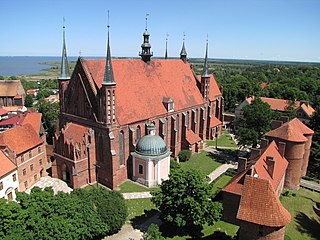
.jpg/220px-Wejście_na_plażę_-_panoramio_(2).jpg)
The Gdańsk Bay(Polish: Zatoka Gdańska) is part of the Baltic Sea and belongs to Poland (Voivodeships Pomerania and Warmia-Masuria) and Russia (Kaliningrad). In the southeast it is through the Fresh spit from Fresh lagoon severed. In the north this forms from the Hel Peninsula completed section the Cute bay. In Poland it becomes the Gdansk Coast with the Kashubian coast and the Vistula Delta counted.
places

- On the Hel Peninsula
- At the Cute bay
- 6 Swarzewo
- 7 Gnieżdżewo
- 8 puck

- 9 Błądzikowo
- 10 Rzucewo
- 11 Osłonino
- 12 Beka
- 13 Rewa
- 14 Mechelinki

- 15 Pierwoszyno
- 16 Kosakovo

- in the Vistula Delta
- On the Fresh Spit
- At the Fresh lagoon
Other goals
background
The Gdańsk Bay is mainly located in northern Poland. It is shaped by glaciers, rivers (especially the Vistula), wind and ocean currents during the Vistula glacial period. There are shifting dunes, beach lakes, moraines, cliffs and river deltas. In contrast, there are no significant tides and therefore no Wadden Sea.
language
Polish is the official language in Poland and Russian is the national language in Russia. One gets along well with English in Poland.
getting there
By plane
At Danzig is there 1 international airport![]() (IATA: GDN). At Olsztyn (German Allenstein) in Warmia-Masuria is the Olsztyn-Mazury Airport
(IATA: GDN). At Olsztyn (German Allenstein) in Warmia-Masuria is the Olsztyn-Mazury Airport![]() (IATA: SZY).
(IATA: SZY).
By train
The Bay of Gdańsk can be reached by train via Gdańsk. The central hub is the Gdańsk Główny Railway Station (Gdansk Central Station).
In the street
The Bay of Gdańsk can be reached by car and long-distance bus via the motorway (A1) or the expressway (S6) easily and quickly accessible from Szczecin and central Poland.
By boat
The great ports Danzig and Gdynia are the place of departure and destination for ferries to / from Scandinavia.
By bicycle
Two long-distance cycle routes lead through the region: the Baltic Sea Cycle Route as well as the Iron Curtain Europe Cycle Route.
On foot
The European long-distance footpath E9 leads through the region.
mobility
Within the densely populated region, you can get around easily by public transport (bus, train, boat). If you want to get on the fresh spit, it is best to use a car, as there is no train connection here.
The leads directly along the Gdańsk Bay Baltic Sea Cycle Route (also designated as EuroVelo 10).
Tourist Attractions
- Danzig - old town
- Elblag - old town
- Marienburg - Ordensburg
activities
The Bay of Gdańsk is particularly ideal for sunbathing and water sports on the beach.
kitchen
Due to the proximity to the open sea but also to inland waters, marine and freshwater fish are the main components of the regional cuisine. Forest fruits, mushrooms and game supply the dense coastal forests of Kashubia.
nightlife
Outside the summer season, the nightlife is concentrated in the larger cities such as Gdansk, Gdynia, Elblag or Sopot. In summer, on the other hand, there is a lot going on almost everywhere.
security
The Baltic coast usually falls flat under water and there are hardly any tides or unpredictable currents. Bathing is therefore usually safe for families with children and swimming accidents are rare. When swimming accidents do occur, excessive alcohol or drug consumption is usually involved. However, if you follow the general bathing rules and do not go into the water when the waves are high, you have little to fear.
climate
There is a transitional climate between maritime and continental climates in Gdańsk Bay. The amount of precipitation is lower and the temperature fluctuations higher (warmer summers, colder winters) than on comparable coasts in Western Europe.
literature
See article too Poland.









.jpeg/350px-Puck_Bay_After_Winter_Hd_Wallpaper_(30158459).jpeg)







.jpg/311px-00_sea_towers_(April_2018).jpg)




_ID_637011.jpg/350px-SM_Stegna_Kościół_Najświętszego_Serca_Pana_Jezusa_(4)_ID_637011.jpg)




_ID_644686.jpg/350px-SM_Elbląg_Kościół_św_Mikołaja_(3)_ID_644686.jpg)
.jpg/350px-Gmina_Tolkmicko,_Poland_-_panoramio_(6).jpg)





